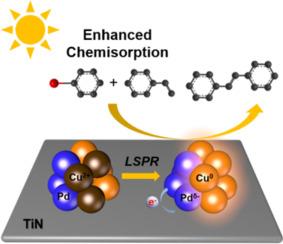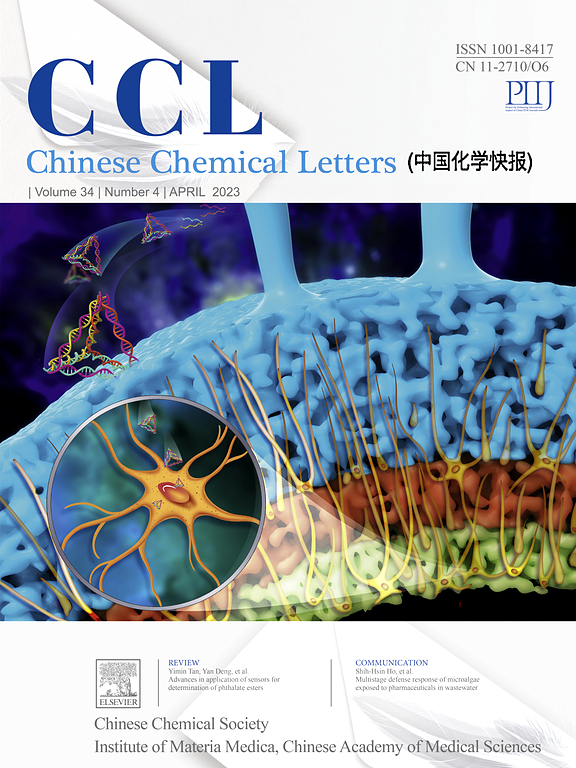Visible light excitation on CuPd/TiN with enhanced chemisorption for catalyzing heck reaction
IF 9.4
1区 化学
Q1 CHEMISTRY, MULTIDISCIPLINARY
引用次数: 0
Abstract
In this work, we developed plasmonic photocatalyst composed of CuPd alloy nanoparticles supported on TiN, the optimized Cu3Pd2/TiN catalyst shows excellent conversion (>96 %) and selectivity (>99 %) for Heck reaction at 50 °C under visible light irradiation. By in-situ spectroscopic investigations, we find that visible light excitation could achieve stable metallic Cu species on the surface of CuPd alloy nanoparticles, thereby eliminating the inevitable surface oxides of Cu based catalyst. The in-situ formed metallic Cu species under irradiation take advantage of the strong interactions of Cu with visible light, and manifest in the localized surface plasmon resonances (LSPR) photoexcitation. Visible light excitation could further promote the charge transfer between catalytic Pd component and the support TiN, resulting in electron-rich Pd sites on CuPd/TiN. Moreover, light excitation on CuPd/TiN generates strong chemisorption of iodobenzene and styrene, favoring the activation of reactants for Heck reaction. DFT calculations suggest that electron-rich CuPd sites ideally lower the activation energy barrier for the coupling reaction. This work provides valuable insights for mechanistic understanding of plasmonic photocatalysis.

可见光激发 CuPd/TiN 化学吸附作用增强,可催化 heck 反应
在这项工作中,我们开发了由 CuPd 合金纳米粒子支撑在 TiN 上组成的等离子体光催化剂,优化后的 Cu3Pd2/TiN 催化剂在可见光照射下于 50 °C,对 Heck 反应具有优异的转化率(96%)和选择性(99%)。通过原位光谱研究,我们发现可见光激发可以在 CuPd 合金纳米颗粒表面形成稳定的金属 Cu 物种,从而消除了 Cu 基催化剂不可避免的表面氧化物。辐照下原位形成的金属铜物种利用了铜与可见光的强相互作用,表现为局部表面等离子体共振(LSPR)光激发。可见光激发可进一步促进催化钯成分与支持物 TiN 之间的电荷转移,从而在 CuPd/TiN 上形成富电子钯位。此外,CuPd/TiN 上的光激发会产生强烈的碘苯和苯乙烯化学吸附,有利于活化 Heck 反应的反应物。DFT 计算表明,富电子 CuPd 位点能理想地降低偶联反应的活化能垒。这项工作为从机理上理解等离子体光催化提供了宝贵的见解。
本文章由计算机程序翻译,如有差异,请以英文原文为准。
求助全文
约1分钟内获得全文
求助全文
来源期刊

Chinese Chemical Letters
化学-化学综合
CiteScore
14.10
自引率
15.40%
发文量
8969
审稿时长
1.6 months
期刊介绍:
Chinese Chemical Letters (CCL) (ISSN 1001-8417) was founded in July 1990. The journal publishes preliminary accounts in the whole field of chemistry, including inorganic chemistry, organic chemistry, analytical chemistry, physical chemistry, polymer chemistry, applied chemistry, etc.Chinese Chemical Letters does not accept articles previously published or scheduled to be published. To verify originality, your article may be checked by the originality detection service CrossCheck.
 求助内容:
求助内容: 应助结果提醒方式:
应助结果提醒方式:


